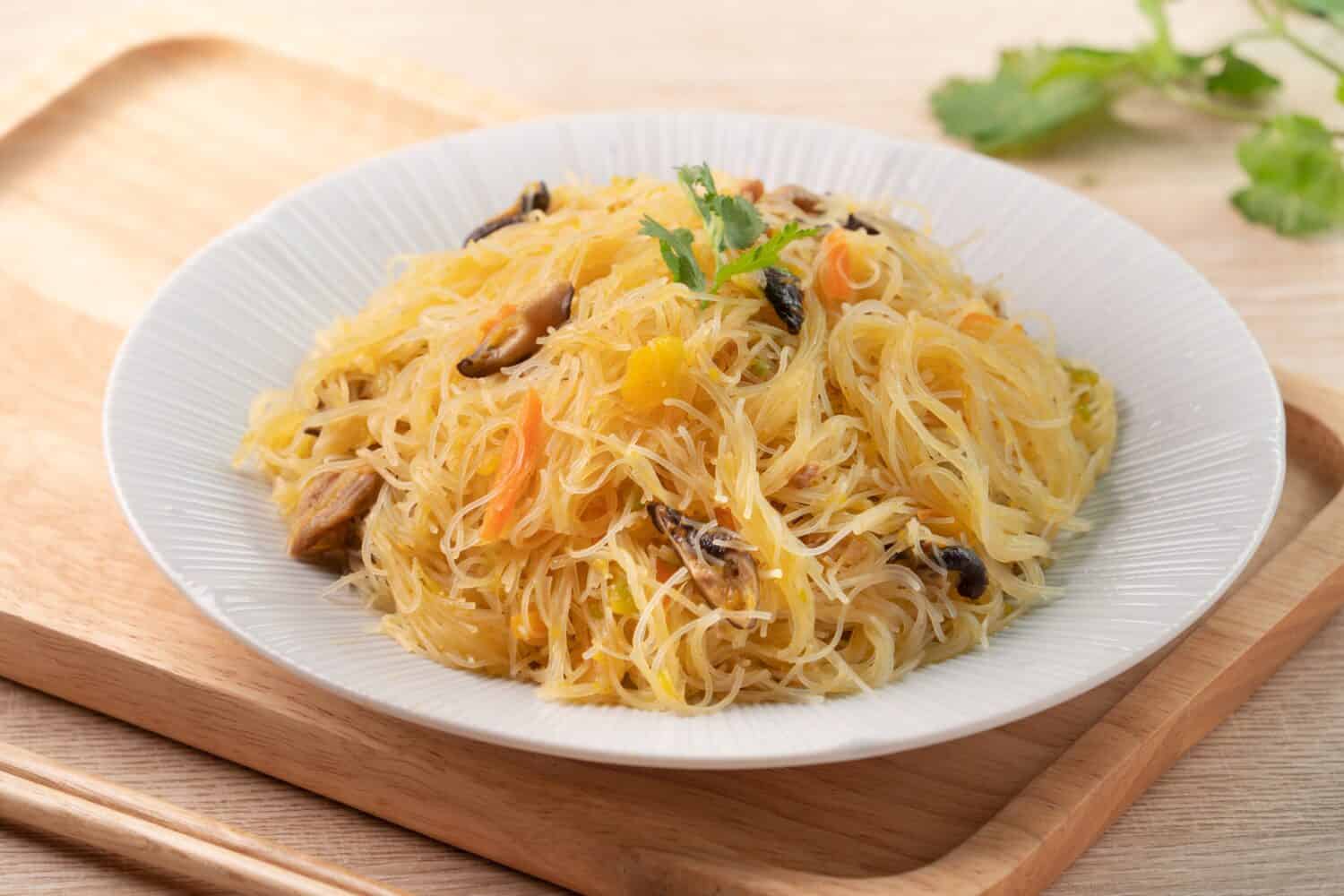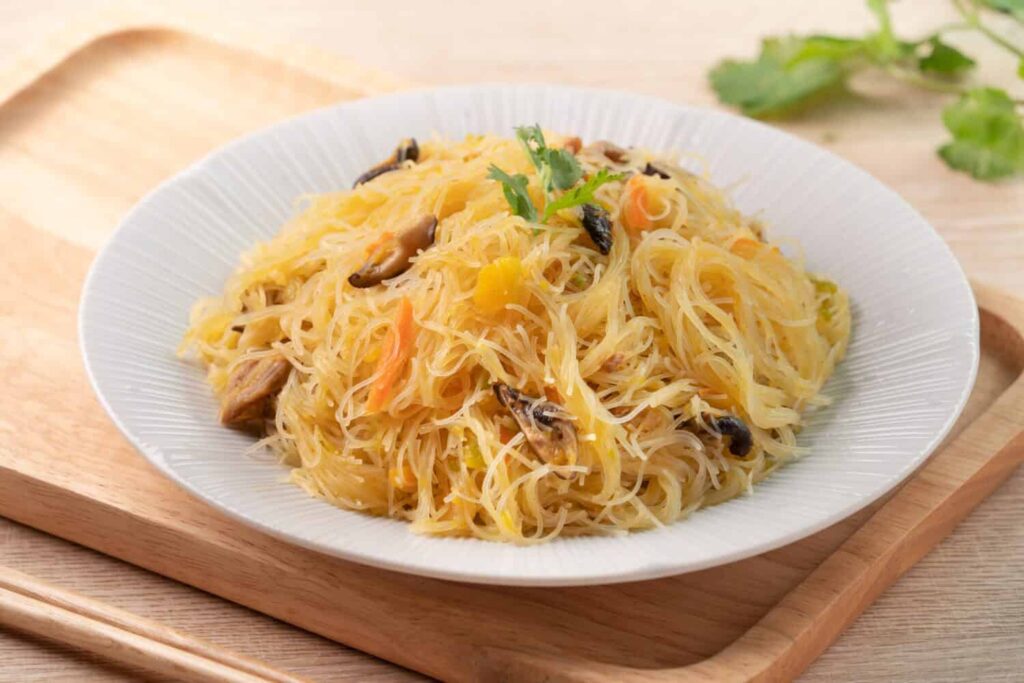The Great Debate: Cellophane Noodles vs Vermicelli – Which One Wins?


Welcome to the ultimate showdown between two Asian noodle heavyweights: cellophane noodles and vermicelli! In this blog post, we’ll explore their rich history, nutritional value, unique textures and flavors, cooking methods, versatility in Asian cuisine, and health benefits. By the end, you’ll be equipped to declare a winner in the great debate: cellophane noodles vs vermicelli. So, grab your chopsticks, and let’s dive in!
Contents [show]
History and Origin of Both Noodles
Cellophane noodles, also known as glass or bean thread noodles, have a captivating history that unfolds over centuries. Emerging in China during the Tang Dynasty (618-907 AD), these translucent strands, crafted from starches like mung beans, potato, or sweet potato, swiftly became culinary treasures prized for their versatility and flavor-absorbing magic.
Vermicelli, on the other hand, traces its roots to Italy. This thin pasta, traditionally born from semolina flour and water, boasts diverse variations across Italian regions. Carried by Arab traders during the Middle Ages, vermicelli found its home in Italian cuisine, radiating its influence across Europe and even reaching Asia through bustling trade routes.
Cellophane noodles are proudly Chinese but have seamlessly merged into the culinary tapestry of countless Asian cuisines—Thai, Vietnamese, Korean, Japanese, etc. Vermicelli remains a beloved staple in Italian cooking, leaving its delectable mark on many Mediterranean dishes.
These two noodle varieties may hail from different corners of the world, but they share a common thread—they both hold indispensable roles in their respective culinary traditions, weaving tales of flavor, history, and cultural richness!
Nutritional Comparison Between Cellophane Noodles and Vermicelli
When deciding between cellophane noodles vs vermicelli, understanding their nutritional differences is key for aligning your choice with dietary preferences and health goals.
Cellophane Noodles:
- Composition: Derived from mung beans, they have a translucent appearance and unique nutrients.
- Caloric and Fat Content: Low in calories and fat, making them a lighter option.
- Gluten-Free: Suitable for gluten-sensitive individuals or those on a gluten-free diet.
- Protein Content: Slightly higher protein content compared to vermicelli.
- Minerals: Rich in iron and calcium, contributing to overall health.
Vermicelli:
- Ingredient Base: Crafted from rice or wheat flour, offering a diverse nutritional profile.
- Gluten Considerations: Rice vermicelli is gluten-free, while the wheat-based variant contains gluten.
- Carbohydrate Content: Comparable to cellophane noodles in carbohydrate content.
- B Vitamins: Rice vermicelli provides essential B vitamins, crucial for energy production.
In essence, the choice depends on individual needs. If you seek a low-calorie option with higher protein content, cellophane noodles might be the better fit.
Cooking Methods and Recipe Ideas for Each Noodle Type
When it comes to cooking methods and recipe ideas, both cellophane noodles and vermicelli offer endless possibilities.
Cellophane Noodles
Cooking Method:
- Soaking: Place cellophane noodles in hot water and soak until they become soft and pliable. This typically takes around 5-7 minutes.
Recipe Ideas:
Stir-Fried Cellophane Noodles
- Sauté vegetables and protein (shrimp, chicken, or tofu) in a wok.
- Add soaked cellophane noodles and stir-fry with soy sauce, garlic, and ginger.
- Toss in your favorite veggies for a quick and flavorful dish.
Cellophane Noodle Salad
- Combine soaked cellophane noodles with shredded vegetables, herbs (cilantro, mint), and protein.
- Dress with a tangy vinaigrette made of lime juice, soy sauce, and sesame oil.
Cellophane Noodle Soup
- Add soaked cellophane noodles to a hot broth with vegetables and protein.
- Flavor with soy sauce, sesame oil, and a dash of chili for a comforting soup.
Vermicelli
Cooking Method:
Boiling: Boil vermicelli in salted water for 3-5 minutes or until tender yet slightly firm. Stir occasionally to prevent clumping.
Recipe Ideas:
Vietnamese Vermicelli Bowl (Bun):
Top a bowl of cooked vermicelli with grilled lemongrass-infused pork, fresh herbs, pickled vegetables, and a drizzle of nuoc cham sauce.
Pad Thai with Vermicelli:
- Stir-fry vermicelli with tofu, shrimp, or chicken in a wok.
- Add a flavorful Thai sauce made with tamarind, fish sauce, and lime.
Vermicelli Stir-Fry with Vegetables:
- Quickly stir-fry vermicelli with a mix of colorful vegetables, tofu, or your preferred protein.
- Season with soy sauce and ginger for a simple and tasty stir-fry.
Cold Vermicelli Salad:
Toss cooked and cooled vermicelli with julienned vegetables, grilled chicken, and a zesty dressing for a refreshing salad.
These cooking methods and recipe ideas provide a starting point, but feel free to get creative and tailor them to your taste preferences!
Availability and Cost
When it comes to availability, both cellophane noodles and vermicelli are commonly found in most grocery stores or Asian markets, making them easily accessible for culinary enthusiasts. However, the specific types may vary depending on location and store inventory.
In terms of cost, cellophane noodles are slightly pricier than vermicelli, though the difference is not significant. Vermicelli, known for its simplicity and widespread production, generally comes at a more affordable price.
Both options provide good value for their respective prices, ensuring a satisfying meal without significant budget constraints. In the availability and cost comparison, there’s no clear winner between cellophane noodles vs vermicelli. The choice ultimately depends on personal preferences, dietary needs, and the intended dish.
So, the next time you’re at the grocery store faced with the noodle dilemma, consider your taste preferences and budget to make the perfect choice for your culinary adventure!
Which One is the Winner?
The showdown between cellophane noodles vs vermicelli reveals a tough call, as each noodle type boasts unique qualities. Choosing between them ultimately hinges on personal preference and the specific dish you’re crafting.
Cellophane noodles, favored for their chewy, slightly sticky texture, excel in soups and stir-fries, holding flavors while keeping their structure. Meanwhile, vermicelli offers a lighter, delicate touch, perfect for salads or pairing with saucy dishes.
Nutritionally, both noodles bring benefits to the table. Cellophane noodles are low-calorie, packing iron and fiber, while vermicelli offers a calorie-conscious option with higher carbohydrate levels for added energy.
Versatility is a shared trait; cellophane noodles can be boiled or soaked, ideal for spring rolls or hot pots, while vermicelli shines in cold noodle salads or alongside grilled meats. Taste-wise, cellophane noodles absorb flavors easily, while vermicelli’s subtle wheat notes add depth without overpowering.
Availability may influence your choice, with cellophane noodles widely accessible at Asian stores or online, and vermicelli commonly found in supermarkets, particularly in the Asian food section.
In this noodle duel, the winner depends on your palate, the dish at hand, and your culinary adventure preferences.
Conclusion
In conclusion, cellophane noodles vs vermicelli, each with its distinctive characteristics, contribute to the rich tapestry of Asian cuisine. Cellophane noodles, derived from mung bean starch, present transparency, low calories, and a satisfying chewiness, while vermicelli, whether rice or wheat-based, introduces diverse textures and flavors to various regional dishes.
The versatility of both noodles spans different Asian culinary traditions, with cellophane noodles featuring prominently in Chinese, Korean, Vietnamese, and Thai recipes, and vermicelli finding its place in Indian, Pakistani, and Southeast Asian cuisine.
Beyond their culinary attributes, cellophane noodles provide a healthful boost with their high fiber content, supporting digestion and weight management. Meanwhile, vermicelli stands out as a reliable source of carbohydrates. The distinct textures of these noodles, characterized by the springiness of cellophane noodles and the softer nature of vermicelli, offer culinary enthusiasts a choice based on personal preference and the desired outcome for specific dishes.
In essence, whether stir-fried cellophane noodles or boiled/soaked vermicelli, these noodles not only contribute to delightful dining experiences but also reflect the rich cultural diversity inherent in Asian gastronomy.
Also Read: The Therapeutic Potential: The Many Health Benefits Of Palmitoylethanolamide




